Saïs Report, Summer 2004
Season Reports
Saïs Report, Summer 2004
Introduction
The summer work was combined with the EES Delta Survey, but at Sais the following was achieved: (1) Three test trenches made in Kom Rebwa West, Excavations 5, 6 and 7; (2) 8 drill cores were made in the Sa el-Hagar area.
Test Trenches in Kom Rebwa West, Sa el-Hagar
Excavation 5
The aim of the trench was to investigate the nature and date of the archaeological material here as well as to assess the potential for deep exacavation. It should be noted that the fields nearby had rice growing in them and this may have affected the water levels. The ground surface consisted of low mounds with salty soil and halfa grass growing in it.
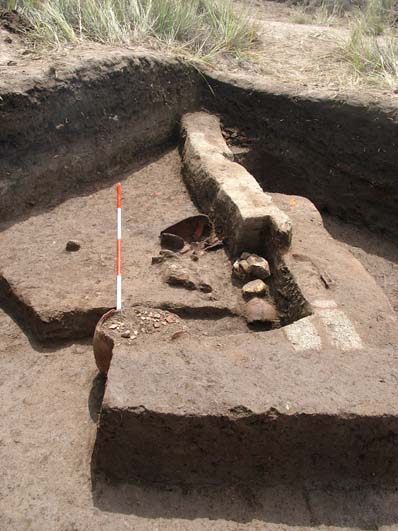 | View of Excavation 5. |
The trench was 5m by 5m in size and finally had a maximum depth of 1.5m below theground level, though in most places was less than this. Water was reached at this level and made further work difficult. Nevertheless several strata (layers) of material were found and the top disturbed surface layer was relatively shallow. The upper layers were of domestic buildings with some mud brick walls and areas of red/black burning with hearths or ovens. There were some vessels set into the ground in the northern side of the trench. The trench was effectively divided by a mud brick wall running from the south west to the north east side of the trench. This had been partly destroyed but it also seems to have had a second wall joining it from the south-east corner. There was a doorway in this corner with a pot reinforcing the threshold and with two limestone blocks used as successive pivot stones. They had been built up one on top of another. Inside the room there were some vessl emplacment fixtures: one a large jar which survived to a height of 50cm and a smashed amphora lying on the floor of the room. The collapsed debris and rubbish fill of this room efectively made the the floor a sealed context, but it seemed to have been quite disturbed.
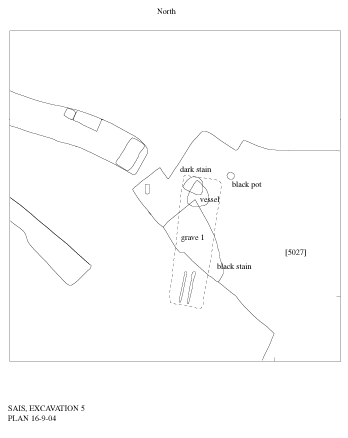
Plan of Excavation 5.
Click image to view at full-size (requires PDF Viewer browser plug-in)
The fill of the whole area contained pottery which seemed to be mostly TIP in date (Dynasty 22-23). One of the most distinctive types of pottery was goblets or chalices with ring base feet, slender, sometime quite short stems and flared cups which had very fine rims in many cases. They often have a red slip. The other finds from the area were predominantly flints (mostly cutting blades and sickle blades) and two beads. A number of ditinctive ‘Medum’ ware Old Kingdom sherds were mixed in with the pottery, which must have been used in the brickwork of the buildings here.
The second main stratum was an area of human burials. Evidence for two and possibly three burials was found here, the main grave [5024] consisting of a body lying north to south, its arms by its sides with its head facing east but placed inside a pottery vessel.
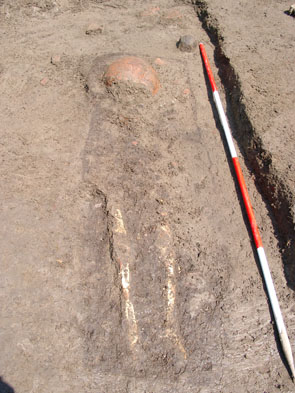 | The vessel was very badly fired and did not have a rim. The body appeared to have no burial goods, except perhaps a small damaged cup which was lying on its chest (though this could have been placed here by chance. The body had been placed in a shallow grave in the ground and seems to have been covered with dark burnt material. It was very badly damaged by water (lying at the water table level), but seemed to have no hands or feet. The main grave. |
A second burial consisted of the lower legs and feet of a body lying west to east, but it was underneath the western section. A possible third burial was found in the northern section, sonsisting of a grey brick superstructure and possibly the top of the skull of a body just visible in the section. This lower level had some evidence for damaged or collapsed grey brick walls, perhaps parts of the tomb surrounds.
The lack of grave goods made this burial difficult to date but it may be from an earlier TIP or New Kingdom phase and reflects a very poor burial area. The fill of the grave contained pottery from the same type of vessels as above but also other material including bone and a part of a mud sealing with a floral design and imprint of papyrus clear upon it.
The amount of rubbish and fill in the trench gave a good pottery corpus for the area and at least two clear phases of use – a cemetery superseded by a domestic settlement area.
The drill core in this trench showed that cultural material could still be recovered 5.58m below the floor level of this trench and then progress was stopped by a stone or other large object.
Excavation 6
The test trench was also 5m by 5m and was situated about 30m to the east of Excavation 5. Like Excavation 5 it also consisted of domestic settlement built upon an earlier cemetery area, though the phasing (sequence of events and use) here is more complex.
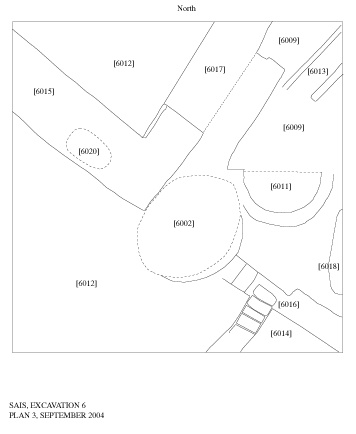
Plan of Excavation 6.
Click image to view at full-size (requires PDF Viewer browser plug-in)
The latest phases of the settlement had a sequence of hearths or ovens built on top of each other which had each produced quantities of burnt debris. There was also a more substantial oval oven of mud brick standing around 1m high which contained some pottery and a large bread tray.
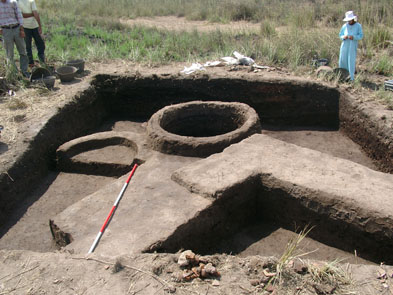 | View of Excavation 6. |
There was the corner of a mud brick building with two walls running from the north-west to south-east and north-east to south-west, joining inside the trench. There were at least 4 to 5 courses of this wall remaining and it may have had a shallow foundation trench as well. Inside the walls a large vessel was found, perhaps associated with a floor or just below floor level. Below this level two human skulls were found, perhaps disturbed during the building of this structure. The wall was about 1m thick, but the eastern side was more indistinct than the western side. The reason for this may have been that it was built against or had collapsed onto an earlier (?) grave [6013]. The grave had a thin grey brick surround and was oriented north-east/south-west with the head facing to the south east.
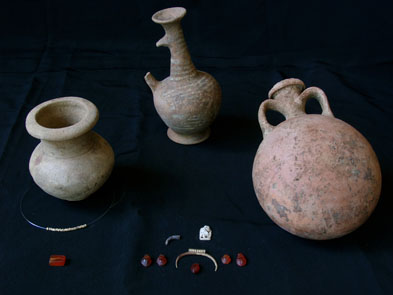 | Grave [6013] contained several burial goods (left): Jar, with red painted decoration and string of small yellow faience ring beads; Cypriot poppy-head flask (handle broken and not present); and Syrian (?) pilgrim flask. |
The vessels had been placed onto the chest of the body in this order from the head down. At the neck there was a necklace with 4 carnelian stylised scarab pendants, a carnelian heart pendant, a gold crescent/horns pendant, a silver snake head and an openwork white faience Taweret amulet. On the right wrist there was a carnelian, rectangular amulet with stylised wedjat-eye incised on both sides. The Poppy-head flask and jar date to Dynasty 18 and the early New Kingdom, but the broken condition of the flask suggests they may have been handed down and so the date of this burial may be a little later.
A further burial was found under the eastern section, but only half of the body could be uncovered. It did not seem to have any grave goods and was buried with its head to the south, on its back and oriented south-north.
The pottery from the upper fill of this trench was the same as that in Excavation 5, evidently part of the same TIP settlement- earlier cemetery sequence. The drill core in this trench suggested that cultural material could still be recovered at 8.63m below the base level of the trench, and this material was not just potetry but also charcoal and a flint. This rich settlement debris is interesting and impressive and shows the potential of this area, provided the probelsm of the water table could be overcome.
Excavation 7
The test trench was 10m by 5m and at the southern edge of the western part of Kom Rebwa. The aim of the trench was to look evidence of monumental building and/or large mud brick structures such as a mud brick enclosure wall. The area chosen was between rice fields and the excavated lake in Kom Rebwa, so that the trench filled with water very quickly, with a maximum depth of just over a metre, though a deep sump was dug down to 2.30m.
Part of this trench may have been used for agriculture and an irrigation ditch, but the sections showed that there was a clear sequence of pits, disturbed destruction layers and muddy fill. The destruction layers contained medium quantities of smashed stone, mostly limestone but also including red and black granite, basalt and orthoquartzite. Most of it was in small piecess but some fragments with tool marks or carved elements were found.
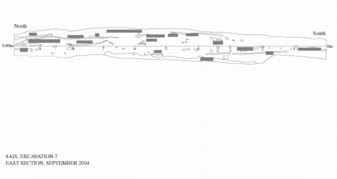 | Eastern section, Excavation 7. Click image to view at full-size (requires PDF Viewer browser plug-in) |
The pottery was distributed relatively evenly throughout the trench, with some more concentrated layers, but they were not very thick. Most of the pottery was Saite in date with a good quantity of Greek imported amphora fragments (including Clazomenian and Samian wares), one fragment of Attic black figure ware and a rim from a
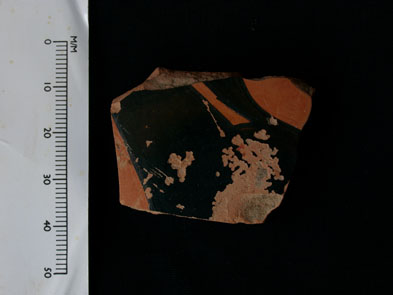 | Black figure sherd. |
substantial krater or amphora. Amongst the Egyptian material there were sherds from the red polished Saite vessels with ridges around the necks, local amphora, lamps, closed jars and a few Old Kingdom sherds mixed in with the material. One almost complete small vessel was found with two holes in the shoulder for hanging. A small pottery head from a female (?) statuette was also found.
Below the upper levels of rubble and pottery the trench became homogenoeous with the matrix becoming sticky and muddy and having a distinctive blue-black mottling colour. This seems to indicate marsh or plant growth at some stage, so was probably submerged with reed beds at some point in time. The deeper sump in the north-eastern corner showed that this matrix continued to about 2.5 metres below the surface. The lack of concentrations of pottery or of archaeological features suggests that either they weren’t here, or that this is dense mud brick with only the sherds used to make the bricks. The structure of the bricks may not show up after being submerged underwater and marsh plants. Three drill cores were attempted in this trench, but all of them failed to go down very far because they hit a stone. In the case of the second and third drill cores this may have been one large stone. It suggests that if this is broken up stone, the ‘destruction layers’ here may well be deep.
The trench showed the presence of Saite material in Kom Rebwa for the first time and lends weight to the idea that the Saite layers have been removed from this area, exposing the earlier material remains of the Third Intermediate Period and the New Kingdom.
Summary
The results of the test trenches demonstrated the potential for uncovering evidence for the Third Intermediate Period settlement at Sais, a crucial period for the development of power in this part of the west delta. They also showed that the water level is more of an issue than in Kom Rebwa East and that any further work will need to use pumping equipment to reach the material at the depths suggested by the drill cores in Excavations 5 and 6.
Drill Augur (Core) Survey in Sa el-Hagar
Eight drill cores were made during the season, mainly in the village and in the excavated areas of Kom Rebwa. They added to the information about the human cultural material lying underneath the village. The cores in the excavated areas of Kom Rebwa were especially interesting because they showed that the settlement deposits here go down 8m in places below the Third Intermediate Period and New Kingdom layers excavated here. This suggests a concentrated settlement area over a long period of time and may be the the ultimate source of the Old Kingdom pottery found in the TIP layers. Some of the lower material is undoubtedly earlier than this and the area may repay deep excavation with dewatering equipment.
Conclusion
The test trenches and drilling have shown that there is considerable archaeological potential in Kom Rebwa West, with a good sequence from the Late New Kingdom through to the Saite period. The work has shown that there are also problems with the water level here, as was to be expected. Further, the strata are quite disturbed and in any case consist of domestic fill and rubish to a large extent. The relationship between the different time periods still needs to be defined and understood. This will go a long way to putting the rise and development of Sais in the Late Period into perspective and also into looking at Sais in the context of the Eastern Mediterranean world as well.
